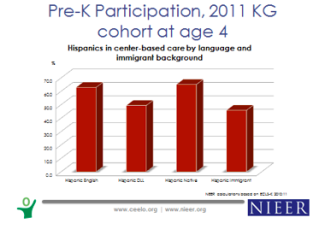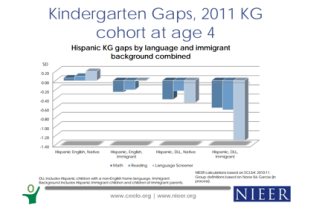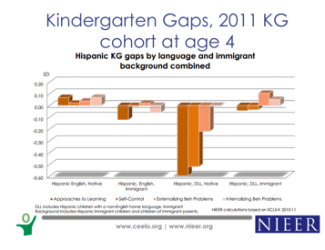
Young immigrants and dual language learners
Participation in pre-K and Kindergarten entry gaps
February 18, 2015
In a recent webinar, NIEER discussed what it means to be Hispanic and a DLL (a dual language learner) or Hispanic and come from a home with immigrant parents. We showed that Hispanic children, DLLs, and children with an immigrant background have lower rates of participation in center-based care (including Head Start) pre-K programs than White non-Hispanic children. We considered the impacts on enrollment of home language and of varied immigrant backgrounds, which make this group quite heterogeneous. We found that enrollment rates do show that while non-DLL Hispanics and Native Hispanics had enrollment rates above 60 percent, much like White children, about 45-50 percent of DLLs and Immigrant background Hispanics were enrolled in center-based care.

That is, only one in two DLL Hispanics or Immigrant Hispanics attend a center-based program. This suggests that aspects of language and immigration status are likely defining why children participate.
We then wondered about similarities between these enrollment patterns and kindergarten entry gaps. Using Whites as the group of reference, it turns out that Hispanic DLLs and Hispanic immigrant children have very large performance gaps in reading, math, and language. These two groups pretty much drive the overall Hispanic gaps observed at kindergarten. What about Hispanic children who are both DLL and of immigrant background? Hispanic DLL children from an immigrant background show very large performance gaps, unlike Native-born English-speaking Hispanics, who fare quite well relative to Whites. It appears we are failing this group.

Patterns are somewhat different when we look at socio-emotional developmental gaps. These do not resemble those for reading, math, and language. On the contrary, while most Hispanics differ little from Whites in terms of approaches to learning, self-control, or problems with externalizing and internalizing behaviors , Hispanic DLL children who are Native-born show large gaps across all of these domains except for internalizing behaviors.

Putting this all together, clearly policy makers should focus on increasing access, outreach, and participation in high-quality early education for any and all Hispanic children, but especially for Hispanic DLL children and children whose parents are immigrants. Moeover, policy makers and practitioners both should recognize how diverse Hispanics are as a group, and how the needs of DLL Hispanic children differ depending on their family histories .
Addressing these issues in early care and education begins with obtaining a better understanding who our children are and who are we serving (and not serving), including:
- screening language abilities
- developing guidelines and standards that address the needs of these groups
- promoting the proliferation of bilingual programs
- and, planning ways to engage and effectively work with diverse groups of Hispanic children.
How well we do this in the first years of their lives will have important consequences for their developmental pathways and their opportunities, and this will be reflected in the our society 15-20 years from now.
–Milagros Nores, PhD, Associate Director of Research
The Authors
Dr. Milagros Nores is the Co-Director for Research and Research Professor at the National Institute for Early Education Research (NIEER). With a profound expertise in early childhood evaluation, informing data-driven policy and programming, cost and benefits of early interventions, evaluation design, equity, and English language learners, she has established herself as a leading researcher in the field of early care and education.
About NIEER
The National Institute for Early Education Research (NIEER) at the Graduate School of Education, Rutgers University, New Brunswick, NJ, conducts and disseminates independent research and analysis to inform early childhood education policy.

